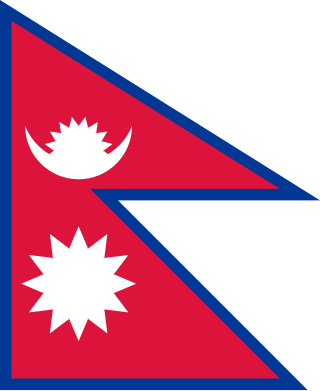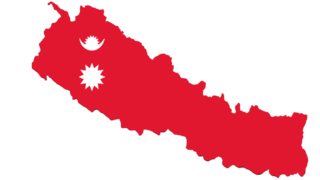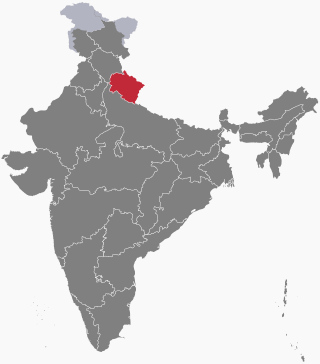
The national flag of Nepal is the world's only irregular flag acting as both the state flag and civil flag of a sovereign country. The flag is a simplified combination of two single pennons, known as a double-pennon. Its crimson red is the symbol of bravery and it also represents the color of the rhododendron, Nepal's national flower, while the blue border is the color of peace. Until 1962, the flag's emblems, both the sun and the crescent moon, had human faces, but they were removed to modernize the flag.

Nepal, officially the Federal Democratic Republic of Nepal, is a landlocked country in South Asia. It is mainly situated in the Himalayas, but also includes parts of the Indo-Gangetic Plain. It borders the Tibet Autonomous Region of China to the north, and India in the south, east, and west, while it is narrowly separated from Bangladesh by the Siliguri Corridor, and from Bhutan by the Indian state of Sikkim. Nepal has a diverse geography, including fertile plains, subalpine forested hills, and eight of the world's ten tallest mountains, including Mount Everest, the highest point on Earth. Kathmandu is the nation's capital and the largest city. Nepal is a multi-ethnic, multi-lingual, multi-religious and multi-cultural state, with Nepali as the official language.

The culture of Nepal encompasses the various cultures belonging to the 125 distinct ethnic groups present in Nepal. The culture of Nepal is expressed through music and dance; art and craft; folklore; languages and literature; philosophy and religion; festivals and celebration; foods and drinks.

The Himalayan monal, also called Impeyan monal and Impeyan pheasant, is a pheasant native to Himalayan forests and shrublands at elevations of 2,100–4,500 m (6,900–14,800 ft). It is part of the family Phasianidae and is listed as Least Concern on the IUCN Red List. It is the national bird of Nepal, where it is known as the danphe or danfe, and state bird of Uttarakhand, India, where it is known as monal. The scientific name commemorates Lady Mary Impey, the wife of the British chief justice of Bengal, Sir Elijah Impey.

Religion in Nepal encompasses a wide diversity of groups and beliefs. Nepal is a secular nation, and secularism in Nepal under the interim constitution is defined as "religious and cultural freedom, along with the protection of religion and culture handed down from time immemorial." That is, "the state government is bound for protecting and fostering Hindu religion" while maintaining "religious" and "cultural" freedom throughout the nation as fundamental rights.

The Emblem of Nepal is the national emblem of Nepal and is used by the Government of Nepal and many government agencies. On 13 June 2020, the emblem was revised to include the newly issued map which includes Nepalese claims to the Kalapani territory and Lipulekh Pass.

The Dhaka topi, or Nepali topi, is a hat which is popular in Nepal, and which forms part of Nepalese national dress, worn by men on celebrations.

Wildlife diversity is a notable feature of Nepal. Because of the variance in climate, from tropical to arctic, Nepal has a large variety of plants and animals. Wildlife tourism is a major source of tourism in the country. There are some animal species which are unique to Nepal, such as the spiny babbler. Nepal is also host to many rhododendron species. Nepal has numerous national parks and reserves to protect its diverse fauna. Nepal is a biodiversity hot spot with ecoregions broadly comprising the mountainous ecoregion, the savanna and grasslands ecoregion of the terai (foothills), and the Rara Lake ecoregion.

There are two dozen languages of Bhutan, all members of the Tibeto-Burman language family except for Nepali, which is an Indo-Aryan language, and Bhutanese Sign Language. Dzongkha, the national language, is the only native language of Bhutan with a literary tradition, though Lepcha and Nepali are literary languages in other countries. Other non-Bhutanese minority languages are also spoken along Bhutan's borders and among the primarily Nepali-speaking Lhotshampa community in South and East Bhutan. Chöke is the language of the traditional literature and learning of the Buddhist monastics.
Vayu (वायु), Wayu or Hayu (हायु) is a Sino-Tibetan language spoken in Nepal by about 1,520 people in Bagmati Province. Dialects include Pali gau Mudajor Sukajor Ramechhap Sindhuli and Marin Khola.
Kedarnath Wild Life Sanctuary, also called the Kedarnath Musk Deer Sanctuary, is a wildlife sanctuary declared under Wildlife Protection Act, 1972 and located in Uttarakhand, India. Its alternate name comes from its primary purpose of protecting the endangered Himalayan musk deer. Consisting of an area of 975 km2 (376 sq mi), it is the largest protected area in the western Himalayas.It is famous for alpine musk deer, Himalayan Thar, Himalayan Griffon, Himalayan Black bear, Snow Leopard and other flora park and fauna. It is internationally important for the diversity of its flora and fauna.

The Western Himalayan broadleaf forests is a temperate broadleaf and mixed forest ecoregion which is found in the middle elevations of the western Himalayas, including parts of Nepal, India, and Pakistan.

The Eastern Himalayan subalpine conifer forests is a temperate coniferous forests ecoregion which is found in the middle and upper elevations of the eastern Middle Himalayas, in western Nepal, Bhutan, northern Indian states including Arunachal Pradesh and Sikkim and adjacent Myanmar and China.

The Western Himalayan subalpine conifer forests is a temperate coniferous forests ecoregion of the middle and upper elevations of the western Middle Himalayas of Nepal, India, and Pakistan.

Daura-Suruwal is one of the national outfit of Nepalese men. The Daura is a variant of the Kurta and is the upper garment, the Suruwal is the trouser. The coat was added to the costume by Jang Bahadur Rana, a prime minister of Nepal in the 19th century. The outfit is also popular in Darjeeling in neighbouring India amongst people of Indian Gorkha origin.
Manang, also called Manangba, Manange, Manang Ke, Nyishang, Nyishangte and Nyishangba, is a Sino-Tibetan language spoken in Nepal. Native speakers refer to the language as ŋyeshaŋ, meaning 'our language'. It is one of half a dozen languages of the Sino-Tibetan family. Manang and its most closely related languages are often written as TGTM in literature, referring to Tamang, Gurung, Thakali, and Manangba, due to the high degree of similarity in the linguistic characteristics of the languages. The language is unwritten and almost solely spoken within the Manang District, leading it to be classified as threatened, with the number of speakers continuing to decline. Suspected reasons for the decline include parents not passing down the language to their children, in order to allow for what they see as more advanced communication with other groups of people, and thus gain more opportunities. Due to the proximity of the district to Tibet, as well as various globally widespread languages being introduced into the area, use of the native language is declining in favor of new languages, which are perceived to aid in the advancement of the people and region.

The Central Zoo(Nepali: सदर चिडियाखाना) is a 6-hectare (15-acre) zoo in Jawalakhel, Nepal. It is home to some 870 animals in 109 species, and is operated by the National Trust for Nature Conservation (NTNC). Although it was originally a private zoo, it was opened to the public in 1956.
Tsum is a language from the subgroup of Tibetic languages spoken by the Tsum people primarily in the Tsum Valley of the Gorka District of Nepal. The language is also known as Tsumke.

Ramaroshan is located in Achham district of Nepal at the altitude of 2500m. A place having 18 patch of meadows, is a major tourism site of Achham district. This area is the one of the habitat of national bird of Nepal, Danfe (Lophophorus). A good view of Budhiganga basin, along with the peaks of Mount Api, and Mount Saipal can be seen from Ramaroshan area.

The following outline is provided as an overview of and topical guide to Uttarakhand:






















